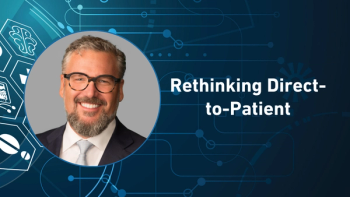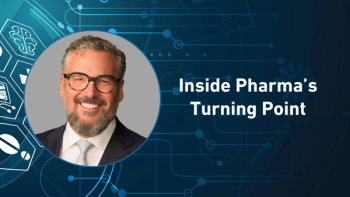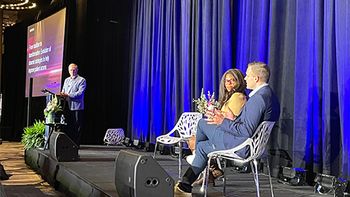
AstraZeneca: Redefining Cancer Care
AZ’s Greg Rossi talks about the company’s oncology activities and his vision for the future of cancer treatment
This month at the European Society for Medical Oncology (ESMO) Congress in Paris (September 9–13, 2022), AstraZeneca (AZ) presented new data supporting its ambition “to redefine cancer care.” A total of 15 approved and potential new medicines from AZ were featured across more than 75 abstracts in 13 tumour types, including results underscoring the efficacy and safety of Imfinzi, Tagrisso, and Lynparza across multiple cancers with high unmet need and data reinforcing Enhertu’s transformative potential in HER2-targetable cancers.
As ESMO was underway, Pharma Commerce sat down with with Greg Rossi, AZ’s senior vice president of oncology, Europe and Canada, to talk about these results, AZ’s other oncology activities, and his vision for the future of cancer treatment.
Pharma Commerce: What key changes have you seen over the course of your career in oncology, and particularly during your last 11 years at AZ?
Greg Rossi: There have been huge advances. When I started 25 years ago, we were talking about how much chemotherapy could we deliver in what we called dose-dense chemotherapy, and how could we support those patients that we knew were going to receive toxicities. Now, we talk about really exquisite chemistry, really exquisite protein engineering, have a deep understanding of biology in terms of biomarkers, and are much more precise in thinking about patient selection. That’s manifested in things like immuno-oncology therapies, where we talk about harnessing the immune system to interact with tumors, or, for example, the antibody drug conjugates (ADCs) such as Enhertu that we have in our pipeline, which I think will be transformative medicines. These represent really intricate engineering work in terms of taking a cell surface protein and basically linking an antibody to it and looking at how you deliver chemotherapy at a dose that is unparalleled into the precise tumor cell. How do you make sure that everything dissociates in the right place at the right time, so that you’re killing the cancer cell but sparing the healthy tissue? A hundred years ago this was the stuff of Paul Ehrlich’s magic bullet, but now it’s a reality. I think it is the biggest transformation we’ve seen, and it’s not stopping there. Where will we go now with this technology we have at our fingertips?
Among these innovations, what have you been proudest to be associated with at AZ?
For me, LYNPARZA has been interwoven in my last 10 years, as it has with many people at AstraZeneca. First, the impact it’s having on patients—whether in ovarian cancer, prostate cancer, pancreatic cancer, or breast cancer—is transformational. And this is complex biology; we were pioneering the science here. We were trying to understand which patients would respond best, how to best use the drug, at what dose, and what schedule. There are two studies in ovarian cancer, the SOLO1 study and the PAOLA-1 study, for which we just presented results at ESMO. The five-year follow-up of the PAOLA-1 Phase III trial showed that LYNPARZA plus bevacizumab meaningfully extended survival with 65.5% of homologous recombination deficiency (HRD)-positive patients surviving 5 years versus 48.4% treated with bevacizumab and placebo, doubling the rates of what you would’ve seen historically. The SOLO-1 Phase III trial demonstrated 67% of advanced ovarian cancer patients with BRCA mutations treated with Lynparza were alive at seven years vs. 47% on placebo. Ten or 15 years ago, that figure of 67% would have been more like 25%. So, that has been a very proud part of the last 10 years for me. And it shows that pioneering in a space is tough—it takes dedication, resilience, and a bit of humility. But when you succeed, you can really have an impact.
How has COVID-19 impacted AZ’s activities in the oncology space?
COVID has clearly had a very significant and negative impact on cancer patients on a number of levels. Firstly, there are the referral rates. I read a report recently saying that up to a million cancer patients went undiagnosed through the pandemic, with 10 million screening appointments missed. We know that diagnosing early is really important if we want to have the opportunity to cure patients. The impact of the pandemic is that more people will be diagnosed at a later stage and their outcomes will be poorer. But I’m proud of AstraZeneca, not just for its work on the COVID vaccine side, but for the effort and energy that the organization put into its oncology efforts during the pandemic. We worked with patient groups and the healthcare system to make sure this issue of timely referral was not forgotten. We supported campaigns in many markets to put the message out there. And we provided support for patients so they could be treated at home, with tools to help review symptoms and toxicities, for example. A lot of these ideas and practices have applications beyond the pandemic; some of the things we were able to do we’re going to apply more broadly going forward.
What kind of innovations are you advancing to help alleviate the health system burden?
First and foremost, AstraZeneca is focused on delivering really high impact medicines in oncology. We’ve delivered seven over the past few years; we hope to double that over the next few years. We have been very faithful to that concept of “the right patient at the right time with the right medicine.” This involves using biomarkers; making sure that health systems understand the potential value of diagnostic technologies and adopt these biomarkers; and making sure that patients are getting the most precise diagnosis that helps match their right treatment. We have positioned, as a central pillar of our oncology strategy, the concept of moving early, because that’s where we think the cure is most appropriate. That requires us to partner with a number of folks within the oncology ecosystem, not just health systems but also technology partners.
One company we’re working with, Grail, for example, has a multi-cancer detection test called the Galleri test that is very interesting and aligns very closely with our principles of being able to diagnose cancer early. And we’re continuing to innovate in diagnostics and medicines in the lung cancer space. There are lots of patients who are not diagnosed early enough with lung cancer. But they might come into the health system for a chest X-ray or something else. We actually saw this during COVID. People were coming in for chest X-rays and the new technologies were picking up potential cancer signals from those images. So, we are working with a couple of companies to take these radiographic images and scan them using AI technologies to identify the 1% of people with what we call incidental pulmonary nodules (IPNs), which could become cancerous, and then triage them into an early referral process. This is where new technology is really starting to make a difference.
We hear about patient-centricity a lot. What have you actually seen in your career in terms of the involvement patients in oncology?
Many companies talk about patient centricity and with very good intentions, but at AstraZeneca it’s a core theme in how we think about the way we develop and commercialize our medicines. But I think it is always worth questioning how we are implementing our plans, strategies, and engagement to validate that patient-centric approach. Actually, I would say there has been an increase in the way we’ve been thinking about that over the last few years. First, we now have a patient partnership program that is a part of how we design our trials. Patients and patient groups can basically come and talk to us about the impact of certain studies from the patient perspective. That’s been very influential. We are also working very closely with patient groups around the support, education, and awareness that they need to manage their disease, and also in terms of policy initiatives. In Europe we are involved with the European Union’s Beating Cancer Plan; that is now expanding to national cancer plans. Having a common purpose with patients, identifying patients appropriately, and promoting early diagnosis is an essential part of our work.
As I mentioned, our COVID learnings showed us how new technologies and tools can be really valuable in the routine care of patients. And we’re thinking more about things like equity and access to clinical trials for different underserved patient groups. What is the variation in access to care across the region and what can we do around that? These are the sorts of areas that have become central to our work more recently and that we are committed to engaging in further.
Can you outline what the next few years will look like in terms of AZ’s oncology efforts?
I think we’ve had a remarkable journey over the last 10 years. Much of what we have been doing has become more visible in the last five years, but it was initiated by CEO Pascal Soriot when he joined in 2012; he really provided the impetus, the pace, and the urgency to change. I’m very excited when I look toward the next 10 years in terms of what we have in our clinical pipeline, our technologies, and the philosophical approach we are taking to partnerships. We know that not all the science is done inside the walls of AstraZeneca, so it requires broad engagement and partnership, both on the science and patient sides.
In particular, our ideas around early diagnosis, precisely identifying patients, and harnessing a range of different technologies in combination to treat them are going to be transformative. Being able to do that in a way that delivers local solutions to physicians and patients around the world is going to take us, I think, to a leadership position in oncology.
Newsletter
Stay ahead in the life sciences industry with Pharmaceutical Commerce, the latest news, trends, and strategies in drug distribution, commercialization, and market access.




